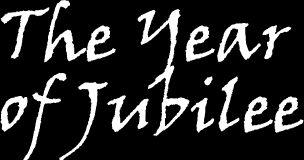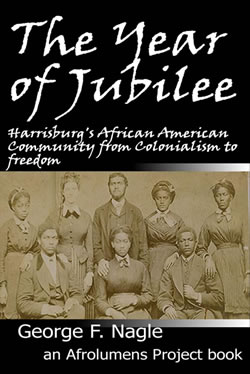
a book about Harrisburg...
by George F. Nagle
Study Areas:
Chapter
Seven
Rebellion
From That Time Down to the Present the Cause Has Been Onward
Shortly after the Harrisburg convention ended, Philip Alexander Bell, editor of the New York abolitionist newspaper the Weekly Advocate, received a letter from John C. Bowers, a seasoned activist from Philadelphia. In his letter, Bowers described the recent events in Harrisburg, having attended the convention as a delegate from the Young Men’s Anti-Slavery Society of Philadelphia, and was one of the few African American delegates there. Although he did not play a major role at the convention, Bowers was effusive in his praise for the experience, and full of optimism for the future of the cause. He recalled his experiences of years past, writing:
A few years ago, the prospect was gloomy, yes, very gloomy. The subject of the immediate emancipation of the bondmen, and the elevation of those who were nominally free, was lost in the sea of forgetfulness, till the thundering tones of William Lloyd Garrison, the Wilberforce of America, Proclaiming to the Slave holder ‘to undo the heavy burden, and let the oppressed go free,’ aroused some few from their lethargy: from that time down to the present the cause has been onward. And what do we now behold? Why 800 Societies, many of which are state societies, and thousands and tens of thousands of valiant souls, both male and female, who are enlisted in the ranks of abolition.73
Bowers then boasted of the newest state society, the creation of which he had just witnessed, and which he himself had just helped to create, proudly noting, “It is with feelings which I am unable to describe, that I am able to inform you, that my native State, Pennsylvania, though last, not least, has also formed a State Society.”
Bowers had attended other such events in his native Philadelphia, but seemed to sense something fresh in the recently concluded abolitionist assembly in Pennsylvania’s capital. He told editor Bell, “I must apprize you, that I never spent a more agreeable time in my life.” His enthusiasm for the events that had just transpired, and his feelings of camaraderie for his fellow abolitionists, both black and white, was not dimmed by a bad experience that the party encountered in Lancaster on the trip home.
Their stagecoach stopped for breakfast at the North American Hotel, a highly respected establishment on the southeast corner of North Queen and Chestnut streets in that town, and Bowers took his seat at the table with the rest of his traveling companions, all of whom happened to be white. An employee that Bowers took to be the barkeep ordered him, because of his race, to leave the table. Naturally, Bowers refused, and AAS agent Samuel Gould immediately came to his defense by asking the barkeep whether he would be satisfied to leave Mr. Bowers alone if the rest of the dining room patrons were not offended by his presence. The employee agreed to abide by the wishes of the rest of his guests, and Gould polled the room, asking if Mr. Bowers should be allowed to keep his seat at the table. According to Bowers’ description of the affair, “there were about fifty yeas and only two nays.” Effectively embarrassed, the employee backed off, and Bowers was served breakfast along with the rest of the white abolitionists.
Before long, however, the owner appeared and again asked Bowers to leave, telling him it would injure the reputation of his hotel “for…any colored man to sit at his table.” The abolitionists gave the landlord a considerable argument, possibly joined by other diners in the room, during the course of which Bowers was able to finish his meal. He then stood, apparently giving in to the owner’s commands, but at that moment the rest of his party stood up from the table and left the hotel along with him, “thus proving to the colored men, and to the world, that they are not abolitionists in word, but in deed, and determined to carry out those principles which they profess.”74 Bowers was deeply impressed with his white comrades’ act of solidarity, and expressed to publisher Bell his newfound hope that African American and white activists could indeed work together in a common cause.
On the surface, John C. Bowers’ observation seemed to hold true for Harrisburg, as African American delegates mingled with white delegates inside the walls of Shakespeare Hall during the days of the anti-slavery convention. Both races worked together to create and vote on the groundwork, preamble, and constitution for the state anti-slavery society, and although there were few African American delegates, they do appear to have held full delegate status.
But there are signs that even in this forum, the white abolitionists did not intend to hand over much power or responsibility to their black fellow activists. It was reported in the United States Gazette, that Lewis Tappan, the American Anti-Slavery Society representative from New York, “expressed his disapprobation, that some of the colored delegates were not among the officers, and declaring it unbecoming to the Convention, that the blacks were obliged to take separate seats.”
The inequities reached deeper than that, however. Not only were African American delegates excluded from holding any offices at the convention, they were not included on any of the working committees during the four days of the convention. No African American delegate gave a major address at the convention, and only one letter from an African American abolitionist, William Whipper, of Columbia, was read in convention and published as part of the proceedings.75
Despite these substantial snubs toward the African American delegates in attendance, the convention stands out as the first time in Harrisburg’s anti-slavery history that black and white abolitionists worked publicly together in a focused common cause. In that regard, John C. Bowers was accurate in his observation that “the cause has been onward.” It marked the beginning of a partnership that would produce amazing results in the coming decade.
Notes
73. Weekly Advocate, 25 February 1837. This newspaper became the Colored American, with Samuel Cornish as editor, in March 1837.
74. Ibid.
75. Proceedings
of the Pennsylvania Convention, 1-78.
The local anti-abolitionist newspaper, the Keystone,
covered the convention in its edition of 4 February, in which it
noted that a speech was given by a “leading negro from the city
of Philadelphia” during a night meeting. There does not appear
to be a transcript of this speech in the published Proceedings.
The Keystone may have been referring to a meeting of
the Harrisburg Anti-Slavery Society, at which several of the
anti-slavery convention delegates made speeches after the
convention was adjourned for the evening. Liberator,
18 February 1837; Keystone, 4 February 1837.
Caution: Copyrighted material. Published September 2010.
© 2010 George F. Nagle
This is the first in a series of books from the Afrolumens Project. Drawing on a large number of sources, and making good use of the treasure trove of information on the pages of the Afrolumens Project, this is the first truly comprehensive history of Harrisburg's African American community.

